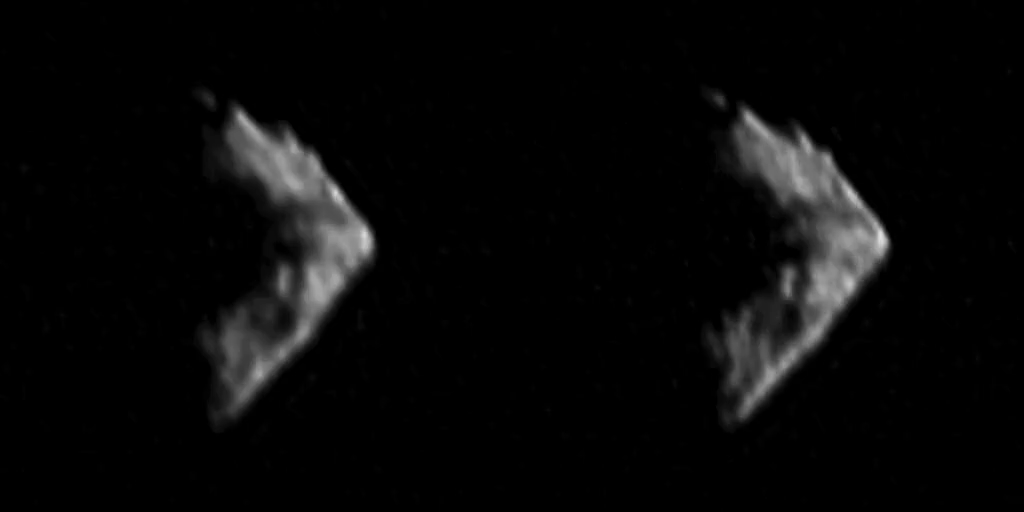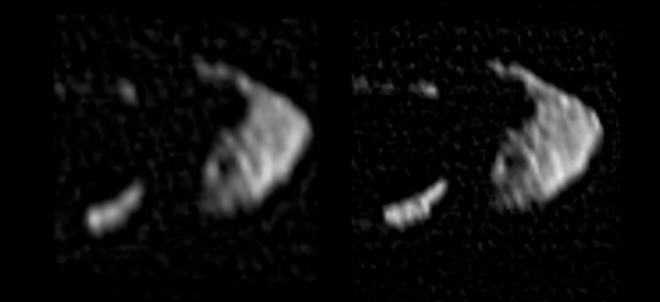1.02.2024
NASA's Lucy asteroid probe to fire main engines in space for 1st time this week
The mission will fire its main engines in space for the first time on Wednesday (Jan. 31), over two years since leaving Earth.
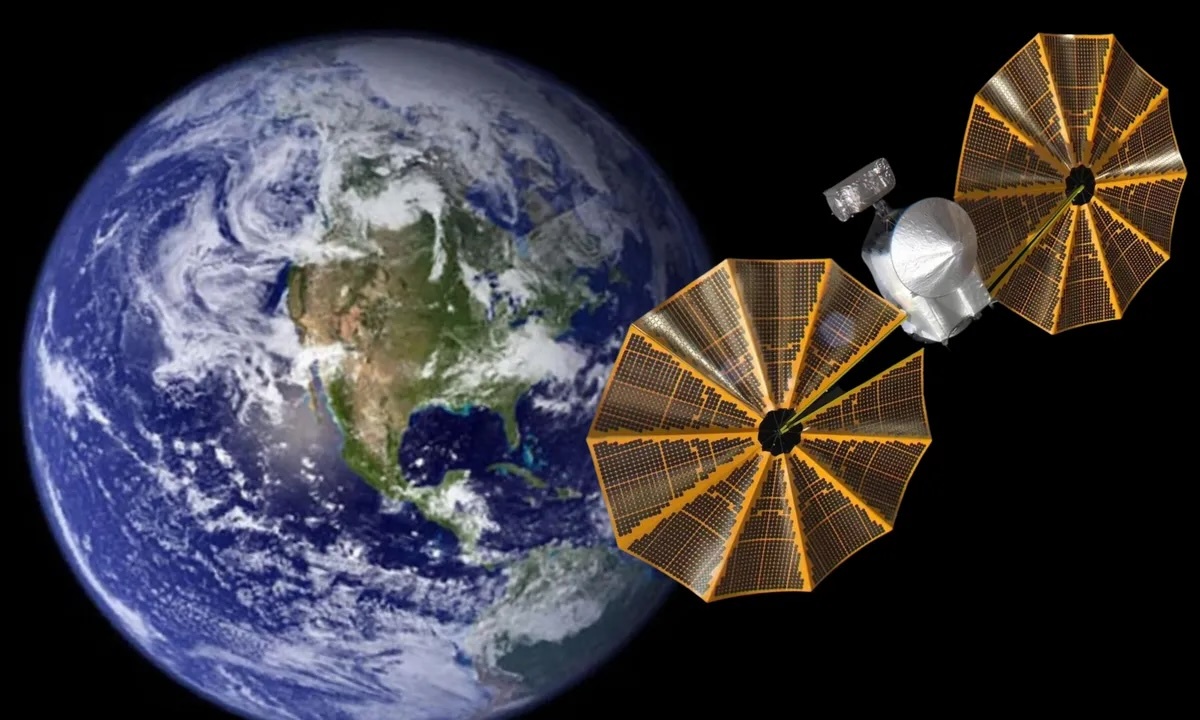
An illustration shows the LUCY spacecraft as it heads back to Earth for a gravity assist in late 2024 (Image credit: NASA?Robert Lea)
NASA's asteroid-hopping Lucy mission is finally getting fired up in space for its trip to the never-before-explored Trojan asteroids, which follow Jupiter as it orbits the sun.
On Wednesday (Jan. 31), the Lucy spacecraft will fire its main engines off-Earth for the first time since its launch in Aug. 2021. The firing of Lucy's main engines will see the spacecraft burn through around half of its onboard fuel. This will be followed by a second, larger maneuver, which NASA says is currently set for Saturday (Feb. 3).
The aim of these two early 2024 operations is to change Lucy's velocity by around 2,000 miles per hour (3,217 kilometers per hour.)
Prior to these two maneuvers, the spacecraft had undergone maximum shifts in velocity of around 10 mph (16 kph), but those were small enough to be achieved by the spacecraft's secondary, less powerful thrusters.
Following these maneuvers, the next major milestone for Lucy will be a flyby of Earth in Dec. 2024, at which time the spacecraft will get a second gravity assistfrom our planet that'll hopefully slingshot it onto a new trajectory. Lucy will come as close as 230 miles (370 kilometers) to the Earth during this flyby.
In particular, the combination of these 2024 maneuvers will shift the spacecraft from its current orbit of the sun, which just skims the main asteroid belt between Mars and Jupiter and allowed it to visit the tiny asteroid Dinkinesh, or 'Dinky' on Nov. 1, 2023. In the process of doing this, Lucy helped NASA scientists discover Dinky is actually a double (double-double, in a way) asteroid system.
The resultant new orbit of Lucy will carry the spacecraft out past the main asteroid belt. During this passage, Lucy will take the opportunity to visit the small main asteroid belt body 52246 Donaldjohanson in April 2025.
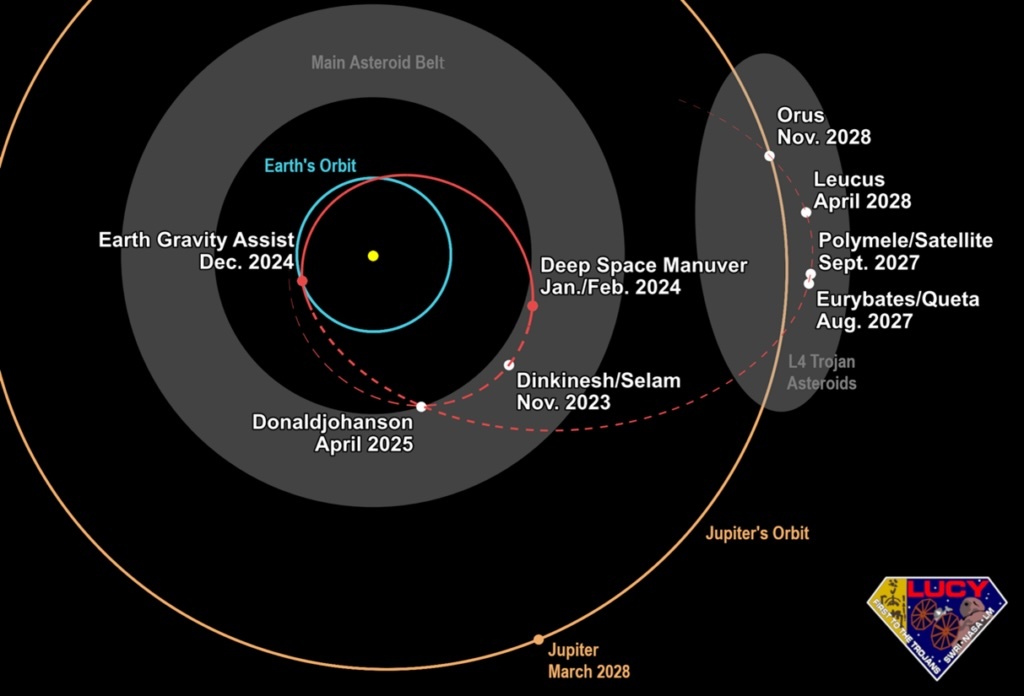
The trajectory of Lucy with major events indicated including its first enginepowered man (Image credit: NASA/Goddard/SwRI)
After this, Lucy will be on track toward Jupiter and to the domain of the Trojans, which share the gas giant's orbit around the sun. The Trojans are arranged in two loose groups, with one set slightly ahead of the gas giant, the Greek camp, and another behind it, the Trojan camp.
Lucy will visit the Greek camp of Trojan asteroids first, setting its sights on the asteroid Eurybates and its satellite or 'moonlet' Queta in August 2027.
After this, the spacecraft will fly past another four Trojan asteroids and three more moonlets, eventually making a final visit to Earth in 2031 before the Lucy mission draws to a close in 2033.
Quelle: SC
----
Update: 30.03.2024
.
NASA's Lucy asteroid-hopping spacecraft pins down ages of 1st asteroid targets
"In this small system, we are seeing incredibly complex processes that are happening."
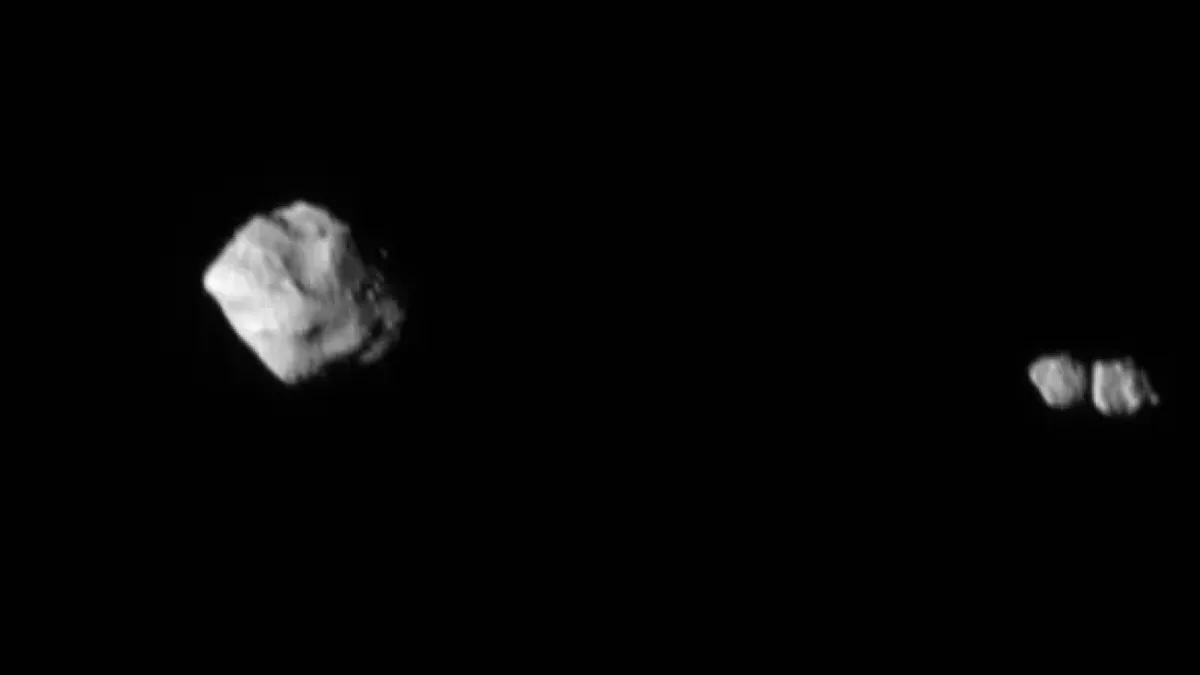
This image shows the asteroid Dinkinesh and its satellite as seen by the Lucy Long-Range Reconnaissance Imager (L’LORRI) as NASA’s Lucy Spacecraft departed the system. From this perspective, the satellite is revealed to be a contact binary, the first time a contact binary has been seen orbiting another asteroid.(Image credit: NASA/Goddard/SwRI/Johns Hopkins APL)
Last November, when NASA's Lucy spacecraft flew past its first official asteroid target named Dinkinesh, it found the space rock was not one, not two but three rocks huddled together. While scientists were surprised to spot Selam, Dinkinesh's natural satellite, they were shocked to discover that Selam itself was, in fact, two objects melded together.
Dinkinesh (Amharic for "marvelous") was randomly selected as an engineering test for Lucy's terminal tracking system that allows the spacecraft to autonomously pinpoint an asteroid's location and keep it within its field of view. Scientists said they had conservative requirements for the probe's stability.
"We totally blew those requirements out of the water," said John Spencer, the mission's deputy project scientist at the Southwest Research Institute (SwRI) in Texas. "We had pin sharp images all the way through the encounter."
"It worked so much better than we expected just in about every way," added Hal Levison, the mission's principal investigator at SwRI.
Earlier this month, Spencer, Levison and other mission members shared with scientists preliminary results from that fortuitous encounter, which resulted in a wealth of data. Speaking at the Lunar and Planetary Science Conference (LSPC) in Texas, they said Dinkinesh and Selam appear to be roughly the same age, have similar ridges on their equators — suggesting mass shedding and re-accretion — and are mildly battered with impacts that left behind detectable craters. Unsurprisingly, the space rocks are also likely to be fragments of larger rocks, said Simone Marchi, the deputy principal investigator of the mission at SwRI.
"It's basically unavoidable," he said. Objects larger than 62 miles (100 kilometers) are more likely to be primordial objects while those smaller are very likely to be ones destroyed by collisions over time, he said. Dinkinesh is a mere 0.5 miles (790 meters) while each lobe on Selam is 0.15 miles (220 meters) wide, so "by necessity it must be a fragment of larger objects."
From the larger craters present on the space rocks, scientists have inferred Dinkinesh to be 7 million years old and Selam about 2 million years old. They say it is intriguing that Dinkinesh and Selam do not have a large age difference (cosmically speaking, 5 million years is a breeze compared to our 4.5-billion-year-old solar system).
"This could tell us something fundamental about the formation of these objects and possibly different processes are responsible for Dinkinesh and Selam," said Marchi.
Selam's two lobes rest on one another, confirming their contact-binary nature, but their apparently thin boundary remained in shadow throughout Lucy's brief encounter. "It is a very, very weak rock," Marchi said of Selam.
Many of the features scientists see on the asteroids' surfaces can be explained by the "YORP effect," which occurs when an asteroid absorbs some sunlight and re-emits that energy as radiation, which then produces a slight thrust that spins up the space rock. Ridges visible on the equators of Dimorphos and Didymos, for instance, are thought to be accretions of material built up after that material was shedded during such a spin up.
"In this small system, we are seeing incredibly complex processes that are happening," said Edward Bierhaus of Lockheed Martin in Colorado.
The Lucy mission, which launched in October 2021, will begin touring its list of primary targets, the Trojan asteroids, starting August 2027. These Trojan asteroids glide in two swarms ahead and behind Jupiter's orbit around the sun. From 2027 to 2033, Lucy will study eight Trojan asteroids, from which scientists hope to gather clues about the creation of our solar system and perhaps the genesis of life on Earth.
Until then, scientists back home will no doubt be busy studying Lucy's data of the serendipitously discovered Dinkinesh system, trying to put together the story of its formation and evolution.
"The fact that this random object turned out to be so interesting and so weird," said Keith Noll, project scientist at the NASA Goddard Space Flight Center in Maryland, "either we got incredibly lucky or there's just generally more complexity in these small asteroids than we thought."
Quelle: SC
----
Update: 31.05.2024
.
NASA Lucy Images Reveal Asteroid Dinkinesh to be Surprisingly Complex
Images from the November 2023 flyby of asteroid Dinkinesh by NASA’s Lucy spacecraft show a trough on Dinkinesh where a large piece — about a quarter of the asteroid — suddenly shifted, a ridge, and a separate contact binary satellite (now known as Selam). Scientists say this complicated structure shows that Dinkinesh and Selam have significant internal strength and a complex, dynamic history.
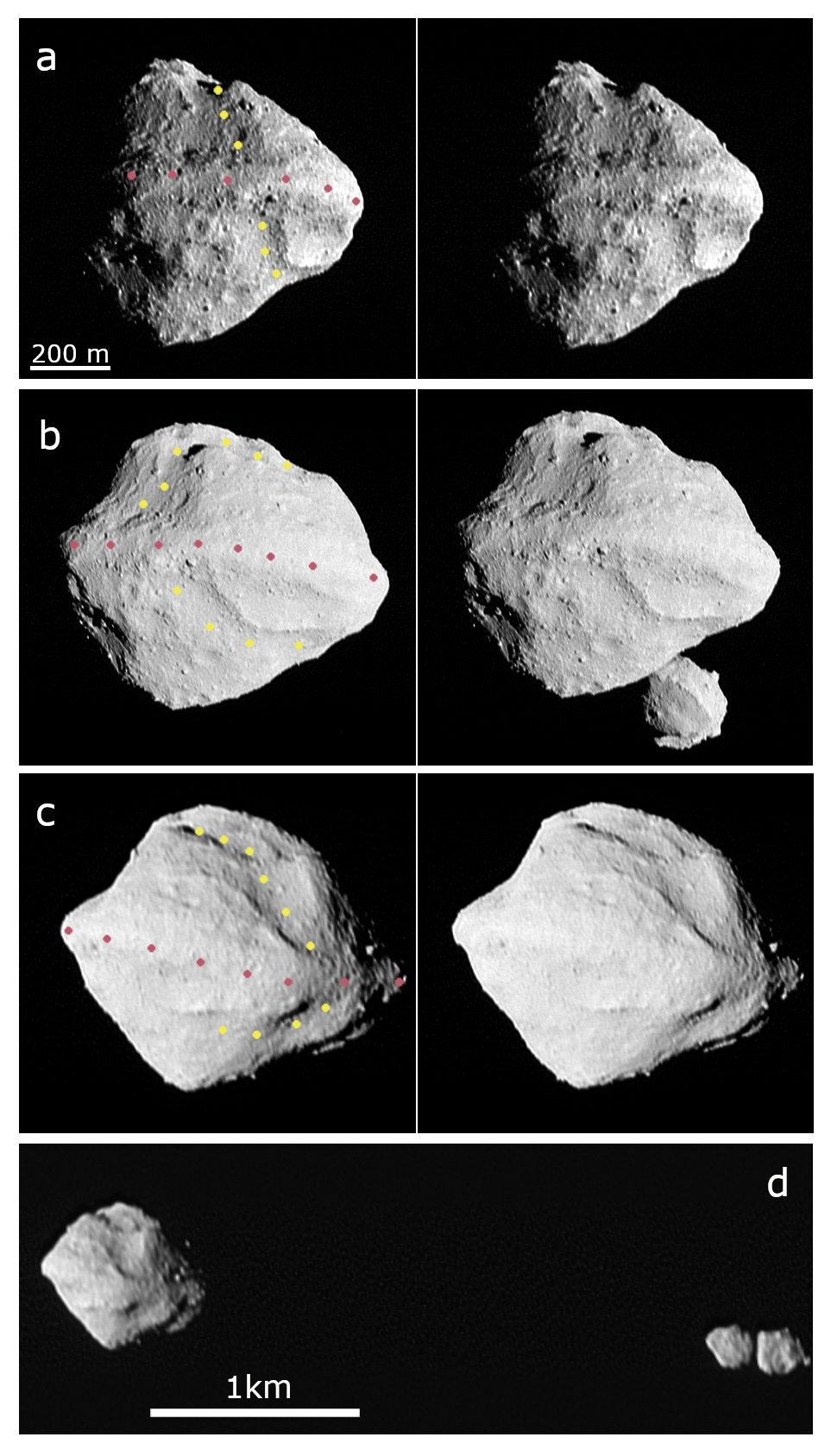
Researchers think that Dinkinesh is revealing its internal structure by how it has responded to stress. Over millions of years rotating in the sunlight, the tiny forces coming from the thermal radiation emitted from the asteroid’s warm surface generated a small torque that caused Dinkinesh to gradually rotate faster, building up centrifugal stresses until part of the asteroid shifted into a more elongated shape. This event likely caused debris to enter into a close orbit, which became the raw material that produced the ridge and satellite.
If Dinkinesh were much weaker, more like a fluid pile of sand, its particles would have gradually moved toward the equator and flown off into orbit as it spun faster. However, the images suggest that it was able to hold together longer, more like a rock, with more strength than a fluid, eventually giving way under stress and fragmenting into large pieces. (Although the amount of strength needed to fragment a small asteroid like Dinkinesh is miniscule compared to most rocks on Earth.)
“The trough suggests an abrupt failure, more an earthquake with a gradual buildup of stress and then a sudden release, instead of a slow process like a sand dune forming,” said Keith Noll of NASA’s Goddard Space Flight Center in Greenbelt, Maryland, project scientist for Lucy and a co-author of the paper.
“These features tell us that Dinkinesh has some strength, and they let us do a little historical reconstruction to see how this asteroid evolved,” said Levison. “It broke, things moved apart and formed a disk of material during that failure, some of which rained back onto the surface to make the ridge.”
The researchers think some of the material in the disk formed the moon Selam, which is actually two objects touching each other, a configuration called a contact binary. Details of how this unusual moon formed remain mysterious.
Dinkinesh and its satellite are the first two of 11 asteroids that Lucy’s team plans to explore over its 12-year journey. After skimming the inner edge of the main asteroid belt, Lucy is now heading back toward Earth for a gravity assist in December 2024. That close flyby will propel the spacecraft back through the main asteroid belt, where it will observe asteroid Donaldjohanson in 2025, and then on to the first of the encounters with the Trojan asteroids that lead and trail Jupiter in its orbit of the Sun beginning in 2027.
Lucy’s principal investigator is based out of the Boulder, Colorado, branch of Southwest Research Institute, headquartered in San Antonio. NASA’s Goddard Space Flight Center in Greenbelt, Maryland, provides overall mission management, systems engineering, and safety and mission assurance. Lockheed Martin Space in Littleton, Colorado, built and operates the spacecraft. Lucy is the 13th mission in NASA’s Discovery Program. NASA’s Marshall Space Flight Center in Huntsville, Alabama, manages the Discovery Program for the Science Mission Directorate at NASA Headquarters in Washington.
Quelle: NASA
----
Update: 27.02.2025
.
NASA’s Lucy Spacecraft Takes Its 1st Images of Asteroid Donaldjohanson
NASA’s Lucy spacecraft has its next flyby target, the small main belt asteroid Donaldjohanson, in its sights. By blinking between images captured by Lucy on Feb. 20 and 22, this animation shows the perceived motion of Donaldjohanson relative to the background stars as the spacecraft rapidly approaches the asteroid.

Lucy will pass within 596 miles (960 km) of the 2-mile-wide asteroid on April 20. This second asteroid encounter for the Lucy spacecraft will serve as a dress-rehearsal for the spacecraft’s main targets, the never-before-explored Jupiter Trojan asteroids. Lucy already successfully observed the tiny main belt asteroid Dinkinesh and its contact-binary moon, Selam, in November 2023. Lucy will continue to image Donaldjohanson over the next two months as part of its optical navigation program, which uses the asteroid’s apparent position against the star background to ensure an accurate flyby.
Donaldjohanson will remain an unresolved point of light during the spacecraft’s long approach and won’t start to show surface detail until the day of the encounter.
From a distance of 45 million miles (70 million km), Donaldjohanson is still dim, though it stands out clearly in this field of relatively faint stars in the constellation of Sextans. Celestial north is to the right of the frame, and the 0.11-degree field of view would correspond to 85,500 miles (140,000 km) at the distance of the asteroid. In the first of the two images, another dim asteroid can be seen photobombing in the lower right quadrant of the image. However, just as the headlights of an approaching car often appear relatively stationary, Donaldjohanson’s apparent motion between these two images is much smaller than that of this interloper, which has moved out of the field of view in the second image.
These observations were made by Lucy’s high-resolution camera, the L’LORRI instrument — short for Lucy LOng Range Reconnaissance Imager — provided by the Johns Hopkins Applied Physics Laboratory in Laurel, Maryland.
Asteroid Donaldjohanson is named for anthropologist Donald Johanson, who discovered the fossilized skeleton — called “Lucy” — of a human ancestor. NASA’s Lucy mission is named for the fossil.
Lucy’s principal investigator, Hal Levison, is based out of the Boulder, Colorado, branch of Southwest Research Institute, headquartered in San Antonio. NASA’s Goddard Space Flight Center in Greenbelt, Maryland, provides overall mission management, systems engineering, and safety and mission assurance. Lockheed Martin Space in Littleton, Colorado, built the spacecraft. Lucy is the 13th mission in NASA’s Discovery Program. NASA’s Marshall Space Flight Center in Huntsville, Alabama, manages the Discovery Program for the Science Mission Directorate at NASA Headquarters in Washington.
Quelle: NASA

